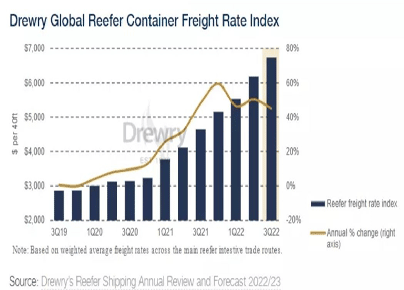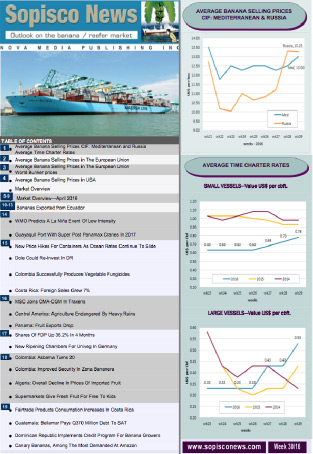Reefer Freight Rates Stabilizing to Outpace Dry Box Prices
2022-08-19

Reefer container freight rates across global trades rose over 50 per cent to 2Q22, matching gains in dry cargo pricing and are estimated to increase further in 3Q22, outpacing dry box rates.
"Some stabilization is already underway on some reefer trades and this is expected to be followed by modest declines through 2023 as cargo owners push back on unsustainable freight rate increases," according to Drewry's recently published Reefer Shipping Annual Review and Forecast 2022/23.
Drewry's Global Reefer Container Freight Rate Index, a weighted average of rates across the top 15 reefer-intensive trade routes, increased over 50 per cent YoY in 2Q22, and the 3Q22 reading is expected to climb further, though the pace of growth will slow (see chart).
"However, East-West routes have seen only modest freight rate increases over the last four quarters as capacity pressure has eased, thanks to the softening pork trade from both Europe and North America to Asia. The exception has been the westbound Transatlantic which saw volume jump as much as 9 percent in the year to 2Q21 while average freight rates doubled over the same period as early opening of the North American economy boosted consumption in the hotel, catering and entertainment sectors."
Reefer container freight rates are expected to soften in 2023 but much less than dry box pricing as reefer rates continue to lag that of the broader trade.
"The reefer supply chain is at a precarious moment with extremely high input costs for materials such as fertilizer, packaging and energy to name just a few," says Philip Gray, head of reefer shipping research, Drewry. "Freight rates remain unsustainably high and many BCOs, particularly those moving low value products, are shipping less as they are priced out of the market. The next round of freight rate negotiations between carriers and cargo owners are expected to take heed of this reality, leading to a modest decline in reefer freight rate levels through 2023."
Despite the present uncertainty, Drewry expects seaborne reefer trade growth to increase at an average annual rate of 3 per cent by 2026. "Despite fears of a global slowdown in trade, supply chain disruption is expected to remain a feature well into 2023," adds Gray. "As BCOs have learnt about their cost, the reefer trade is secondary to the much larger and dominant dry freight trade, which drives carrier network priorities. This reaffirms the need for cargo owners to control their logistics more to ensure timely delivery and optimal product integrity."
Global seaborne reefer traffic increased 2 per cent in 2021 from a pandemic-ravaged 2020, reaching 137.4 million tonnes but has slowed to 1.1 per cent YoY in 1H22. Drewry forecasts the trade will end with an annual gain of just 1%.









